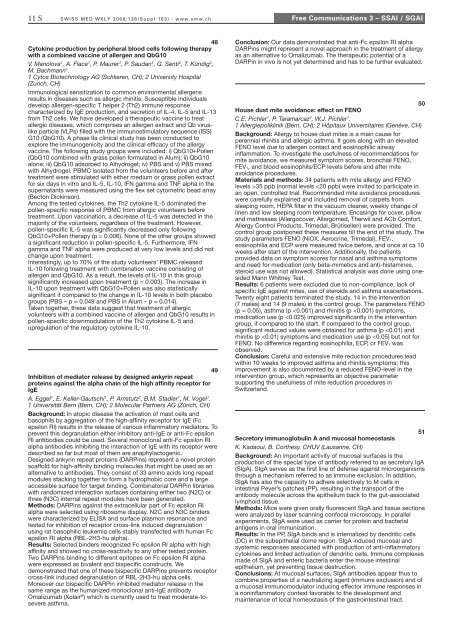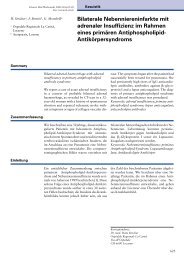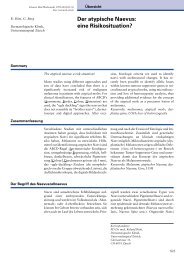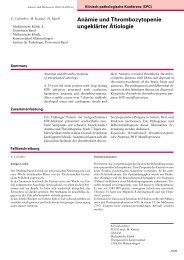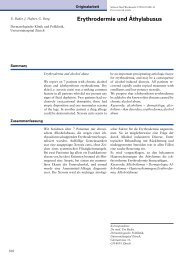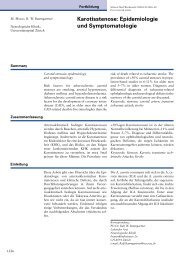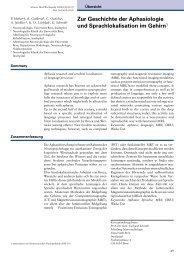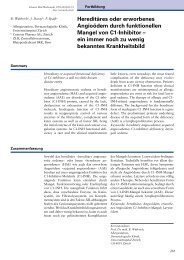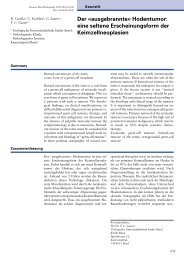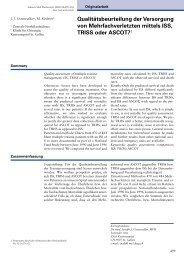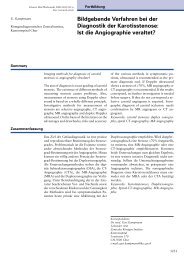Supplementum 163 - Swiss Medical Weekly
Supplementum 163 - Swiss Medical Weekly
Supplementum 163 - Swiss Medical Weekly
You also want an ePaper? Increase the reach of your titles
YUMPU automatically turns print PDFs into web optimized ePapers that Google loves.
11 S SWISS MED WKLY 2008;138(Suppl <strong>163</strong>) · www.smw.ch<br />
Free Communications 3 – SSAI / SGAI<br />
48<br />
Cytokine production by peripheral blood cells following therapy<br />
with a combined vaccine of allergen and QbG10<br />
V. Manolova 1 , A. Flace 1 , P. Maurer 1 , P. Saudan 1 , G. Senti 2 , T. Kündig 2 ,<br />
M. Bachmann 1 .<br />
1 Cytos Biotechnology AG (Schlieren, CH); 2 University Hospital<br />
(Zurich, CH)<br />
Immunological sensitization to common environmental allergens<br />
results in diseases such as allergic rhinitis. Susceptible individuals<br />
develop allergen-specific T helper 2 (Th2) immune response<br />
characterized by IgE production, and secretion of IL-4, IL-5 and IL-13<br />
from Th2 cells. We have developed a therapeutic vaccine to treat<br />
allergic diseases, which comprises an allergen extract and Qb viruslike<br />
particle (VLPs) filled with the immunostimulatory sequence (ISS)<br />
G10 (QbG10). A phase IIa clinical study has been conducted to<br />
explore the immunogenicity and the clinical efficacy of the allergy<br />
vaccine. The following study groups were included: i) QbG10+Pollen<br />
(QbG10 combined with grass pollen formulated in Alum); ii) QbG10<br />
alone; iii) QbG10 adsorbed to Alhydrogel; iv) PBS and v) PBS mixed<br />
with Alhydrogel. PBMC isolated from the volunteers before and after<br />
treatment were stimulated with either medium or grass pollen extract<br />
for six days in vitro and IL-5, IL-10, IFN gamma and TNF alpha in the<br />
supernatants were measured using the flex set cytometric bead array<br />
(Becton Dickinson).<br />
Among the tested cytokines, the Th2 cytokine IL-5 dominated the<br />
pollen-specific response of PBMC from allergic volunteers before<br />
treatment. Upon vaccination, a decrease of IL-5 was detected in the<br />
majority of the volunteers, regardless of the treatment. However,<br />
pollen-specific IL-5 was significantly decreased only following<br />
QbG10+Pollen therapy (p = 0.006). None of the other groups showed<br />
a significant reduction in pollen-specific IL-5. Furthermore, IFN<br />
gamma and TNF alpha were produced at very low levels and did not<br />
change upon treatment.<br />
Interestingly, up to 70% of the study volunteers’ PBMC released<br />
IL-10 following treatment with combination vaccine consisting of<br />
allergen and QbG10. As a result, the levels of IL-10 in this group<br />
significantly increased upon treatment (p = 0.003). The increase in<br />
IL-10 upon treatment with QbG10+Pollen was also statistically<br />
significant if compared to the change in IL-10 levels in both placebo<br />
groups (PBS – p = 0.049 and PBS in Alum – p = 0.014).<br />
Taken together, these data suggest that treatment of allergic<br />
volunteers with a combined vaccine of allergen and QbG10 results in<br />
pollen-specific downmodulation of the Th2 cytokine IL-5 and<br />
upregulation of the regulatory cytokine IL-10.<br />
49<br />
Inhibition of mediator release by designed ankyrin repeat<br />
proteins against the alpha chain of the high affinity receptor for<br />
IgE<br />
A. Eggel1 , E. Keller-Gautschi1 , P. Amstutz2 , B.M. Stadler1 , M. Vogel1 .<br />
1 Universität Bern (Bern, CH); 2 Molecular Partners AG (Zürich, CH)<br />
Background: In atopic disease the activation of mast cells and<br />
basophils by aggregation of the high-affinity receptor for IgE (Fc<br />
epsilon RI) results in the release of various inflammatory mediators. To<br />
prevent this degranulation either inhibitory anti-IgE or anti-Fc epsilon<br />
RI antibodies could be used. Several monoclonal anti-Fc epsilon RI<br />
alpha antibodies inhibiting the interaction of IgE with its receptor were<br />
described so far but most of them are anaphylactogenic.<br />
Designed ankyrin repeat proteins (DARPins) represent a novel protein<br />
scaffold for high-affinity binding molecules that might be used as an<br />
alternative to antibodies. They consist of 33 amino acids long repeat<br />
modules stacking together to form a hydrophobic core and a large<br />
accessible surface for target binding. Combinatorial DARPin libraries<br />
with randomized interaction surfaces containing either two (N2C) or<br />
three (N3C) internal repeat modules have been generated.<br />
Methods: DARPins against the extracellular part of Fc epsilon RI<br />
alpha were selected using ribosome display. N2C and N3C binders<br />
were characterized by ELISA and surface plasmon resonance and<br />
tested for inhibition of receptor cross-link induced degranulation<br />
using rat basophilic leukemia cells stably transfected with human Fc<br />
epsilon RI alpha (RBL-2H3-hu alpha).<br />
Results: Selected binders recognized Fc epsilon RI alpha with high<br />
affinity and showed no cross-reactivity to any other tested protein.<br />
Two DARPins binding to different epitopes on Fc epsilon RI alpha<br />
were expressed as bivalent and bispecific constructs. We<br />
demonstrated that one of these bispecific DARPins prevents receptor<br />
cross-link induced degranulation of RBL-2H3-hu alpha cells.<br />
Moreover our bispecific DARPin inhibited mediator release in the<br />
same range as the humanized monoclonal anti-IgE antibody<br />
Omalizumab (Xolair ® ) which is currently used to treat moderate-tosevere<br />
asthma.<br />
Conclusion: Our data demonstrated that anti-Fc epsilon RI alpha<br />
DARPins might represent a novel approach in the treatment of allergy<br />
as an alternative to Omalizumab. The therapeutic potential of a<br />
DARPin in vivo is not yet determined and has to be further evaluated.<br />
50<br />
House dust mite avoidance: effect on FENO<br />
C.E. Pichler1 , P. Taramarcaz2 , W.J. Pichler1 .<br />
1 Allergiepoliklinik (Bern, CH); 2 Hôpitaux Universitaires (Genève, CH)<br />
Background: Allergy to house dust mites is a main cause for<br />
perennial rhinitis and allergic asthma. It goes along with an elevated<br />
FENO level due to allergen contact and eosinophilic airway<br />
inflammation. To investigate the usefulness of recommendations for<br />
mite avoidance, we measured symptom scores, bronchial FENO,<br />
FEV1, and blood eosinophils/ECP levels before and after mite<br />
avoidance procedures.<br />
Materials and methods: 34 patients with mite allergy and FENO<br />
levels >35 ppb (normal levels


